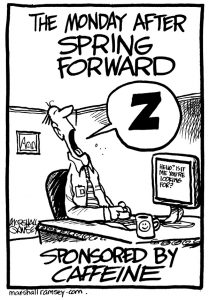In 1768, Benjamin Franklin proposed the idea that more light in the evening would encourage business activity and growth. Throughout the First and Second World Wars, Daylight Saving Time was enacted temporarily to save electricity by taking advantage of more natural light in the evening. In 1966, legislation implemented the national observance of Daylight Saving Time on the same basis of decreasing electrical expenses. Fifty years later, Daylight Saving Time now costs the United States around $434 million annually.
Daylight Saving Time is defined as the time period between spring and fall when clocks are set one hour ahead of standard time. In the United States, the change occurs on the second Sunday of March and first Sunday of November. This change requires reorganizational efforts that are expensive and harm worker health and productivity. Switching time twice a year increases workplace injuries, heart attacks and cyber loafing. Moreover, greater activity in the evening increases vehicular and air conditioning usage, offsetting any gains from decreased amounts of electricity. In Indiana, implementing Daylight Saving Time statewide in 2006 cost households about $9 million in increased electrical bills and about $1.7 to $5.5 million in pollution costs.

To save money, states can choose to opt out of the Daylight Saving Time federal mandate. This is not an unprecedented move. In Arizona where the hot climate generates high air conditioning usage, the state legislature voted in 1968 to abandon Daylight Saving Time after implementation greatly increased A/C costs and spurred public backlash. As a similarly warm Southern state, Texas also uses air conditioning heavily, so the increased costs for greater A/C usage after Daylight Saving Time are even costlier than in other areas of the country. Thus, in addition to expensive losses from decreased business productivity, Texas gives up millions in unnecessarily high gas and A/C expenses due to Daylight Saving Time. Like Arizona, Texas could save energy and money by abolishing the time change.
To eliminate Daylight Saving Time in Texas, legislation must be introduced and passed through the Texas legislature. During the 84th legislative session in Texas, Representative Dan Flynn (R – HD 2) introduced HB 150 which sought to abolish Daylight Saving Time in Texas. In addition to removing organizational costs associated with the time switch, the bill did not require any funding from the Texas budget. This bill has been re-filed for the upcoming legislative session which begins January 10, 2017. The legislation to remove Daylight Saving Time will again have to get approved by committees and then be voted on and passed in the House of Representatives and Senate, a multistep process that can take the entire session. Last session, HB 150 passed through committee to the House floor where it received 56 votes in support and 79 against (including two abstentions). Many legislators against the bill cited the benefit of extra daylight in the evening that allows for more activity after work. However, the significant air conditioning and transportation costs associated with Daylight Saving Time strip money from businesses and Texas citizens that could provide advantages and opportunities beyond an extra hour of afternoon sunlight.
Abandoning the use of Daylight Saving Time does not require a physical change and therefore does not require effort to change clocks or schedules. By saving on air conditioning, gas and lost commercial productivity, Texas would financially benefit from sticking to one time.




